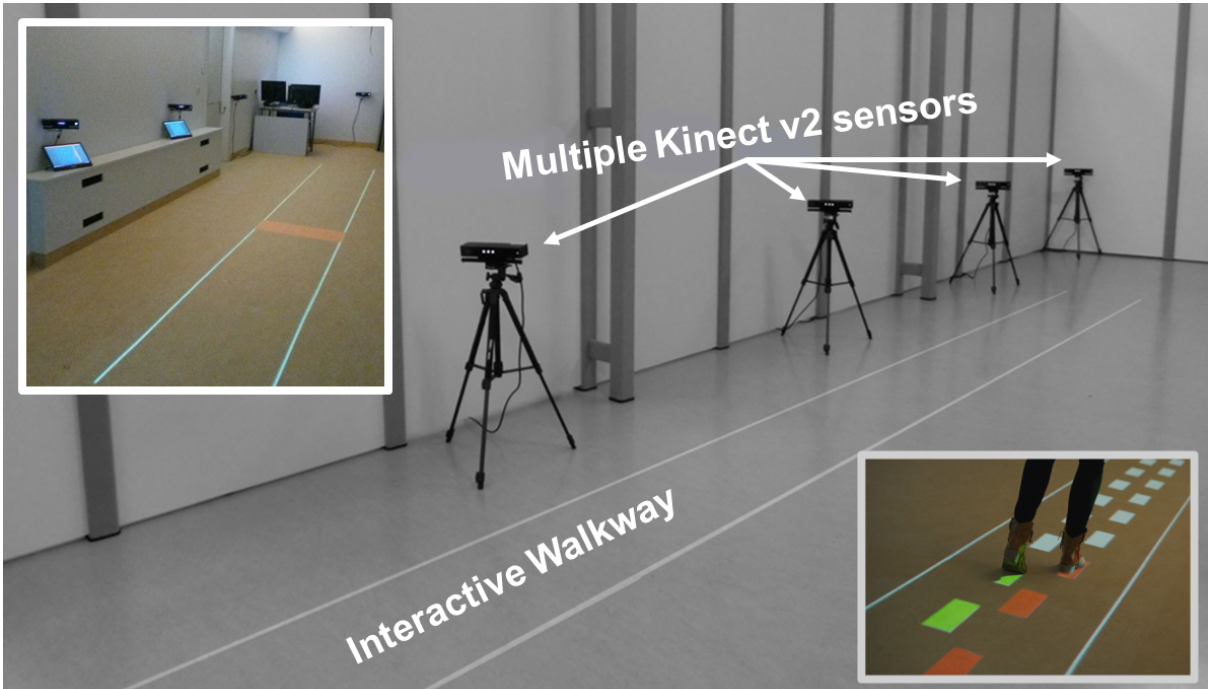We all know that falling is a common, costly and impactful health problem. Most falls occur during walking, caused by trips, slips or misplaced steps. The ability to adapt walking to environmental circumstances largely determines someone’s risk of falling during walking. Nevertheless, set-ups for routine evaluation of gait-environment interactions are not available. To better understand, predict and ultimately prevent walking-related falls, Bert Coolen and I have developed the Interactive Walkway. This overground 10-meter walkway is instrumented with multiple Kinect v2 sensors for markerless 3D full-body movement registration. The walkway further uses a projector to present gait-dependent visual context onto the floor, such as stepping targets and obstacles (see Figure). With the Interactive Walkway the effects of environmental context variations can be examined on a comprehensive set of dependent variables of walking, including self-selected walking speed, gait characteristics, walking adaptability and attentional costs of walking. The Interactive Walkway thus potentially allows for a more task-specific and comprehensive evaluation of walking. In this ISPGR blog, I will discuss a study of my PhD student Daphne Geerse evaluating a multi-Kinect v2 set-up for quantitative gait assessment.
Twenty-one healthy participants of varying gender, age, height and weight performed 10-meter walk tests at both comfortable and maximum walking speeds. Full-body 3D kinematics was registered with the markerless multi-Kinect v2 set-up (see Figure) and a gold-standard active-marker motion-registration system (Optotrak). From these data, basic gait parameters were determined for both systems. Our study showed that body points’ time series and gait parameters, as obtained objectively in a quick, unobtrusive, relatively cheap and participant-friendly manner with a multi-Kinect v2 set-up, match well with those derived with a gold standard in 3D measurement accuracy.
We envisage that by augmenting the walking surface with meaningful context, the Interactive Walkway may be used as a more task-specific evaluation of walking. We are now examining the reliability of outcome measures for various gait-environment interactions in both healthy adults and fall-prone elderly, including patients with Parkinson’s disease and stroke. We will evaluate to what extent they can safely negotiate obstacles (left panel in Figure), accurately place their feet at stepping targets (right panel in Figure), stop-and-go and turn under time pressure. The premise is that by making walking evaluation more task-specific, we can better identify those at risk of falling during walking. Moreover, comprehensive evaluations will help us to better understand why someone is at risk, allowing for patient-tailored fall-prevention interventions.

Publication
Geerse DJ, Coolen BH, Roerdink M (2015). Kinematic validation of a multi-Kinect v2 instrumented 10-meter walkway for quantitative gait assessments. PLoS ONE, 10(10): e0139913. http://journals.plos.org/plosone/article?id=10.1371/journal.pone.0139913
About the Author

Marcelo Pinto Pereira, PT, PhD
MOVE Research Institute Amsterdam, Department of Human Movement Sciences
Vrije Universiteit Amsterdam, The Netherlands
Melvyn Roerdink is ISPGR’s latest promising young scientist award winner. He aspires to better understand walking-related falls by adopting a research approach that attunes diagnosis and treatment to major contributors of falls. He invented and developed the rehabilitation treadmill C-Mill and the Interactive Walkway, systems augmented with gait-dependent visual context.
Copyright
© 2018 by the author. Except as otherwise noted, the ISPGR blog, including its text and figures, is licensed under a Creative Commons Attribution-ShareAlike 4.0 International License. To view a copy of this license, visit https://creativecommons.org/licenses/by-sa/4.0/legalcode.
ISPGR blog (ISSN 2561-4703)
Are you interested in writing a blog post for the ISPGR website? If so, please email the ISGPR Secretariat with the following information:
- First and Last Name
- Institution/Affiliation
- Paper you will be referencing

